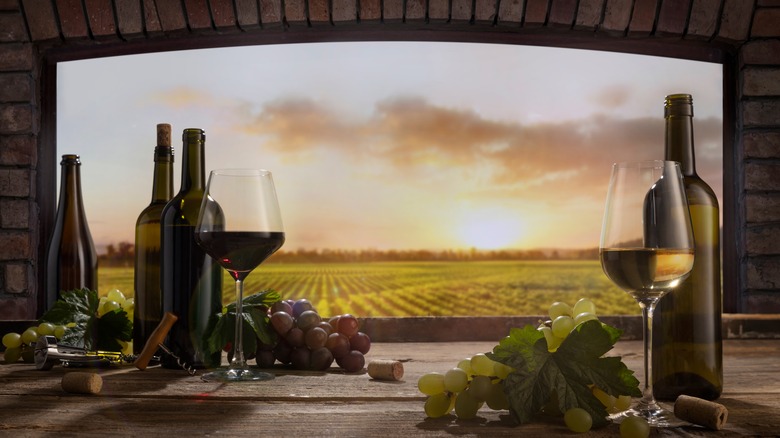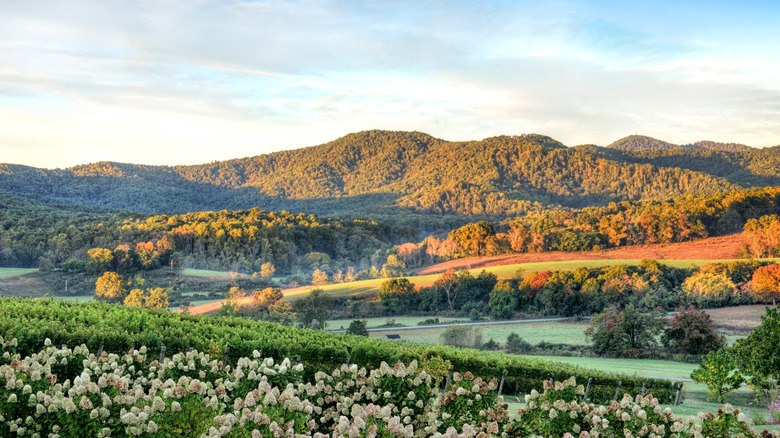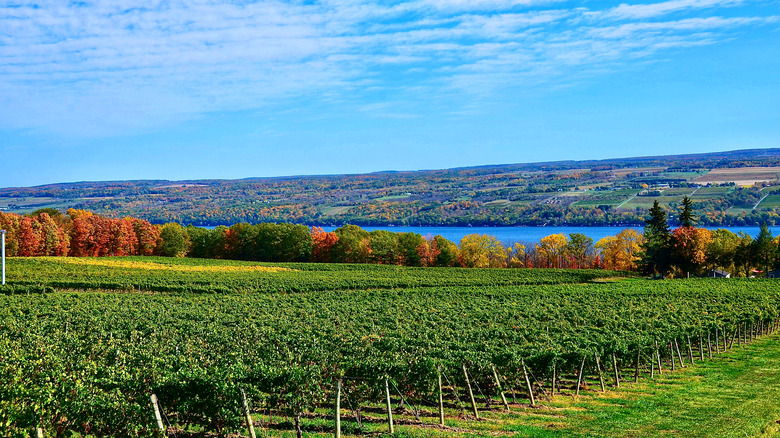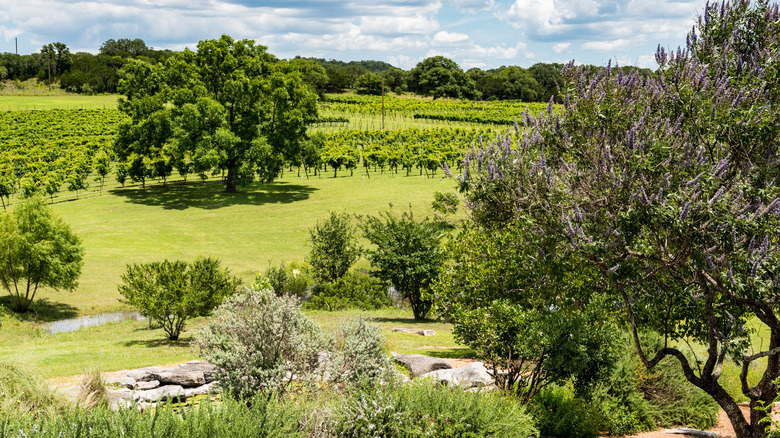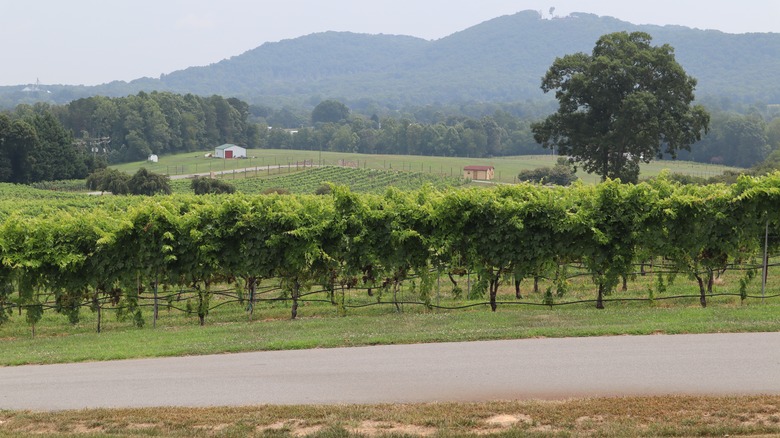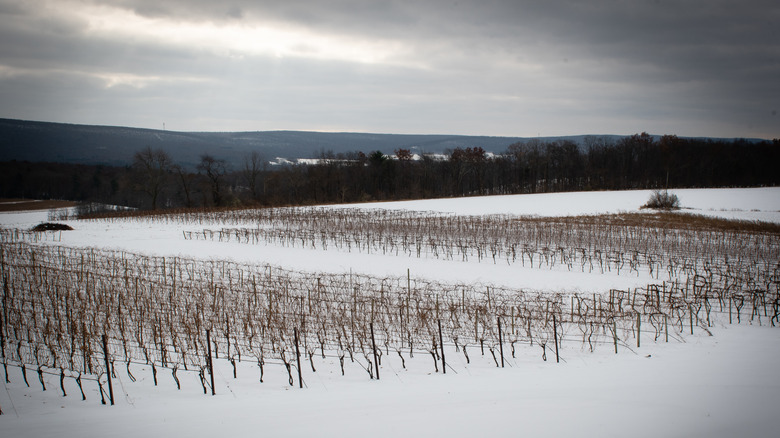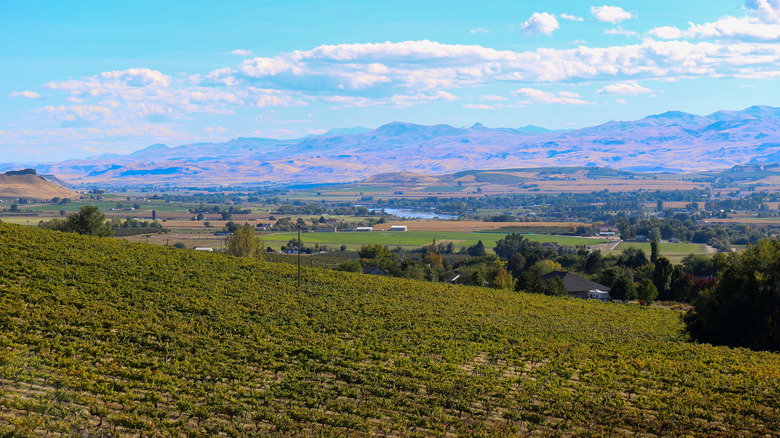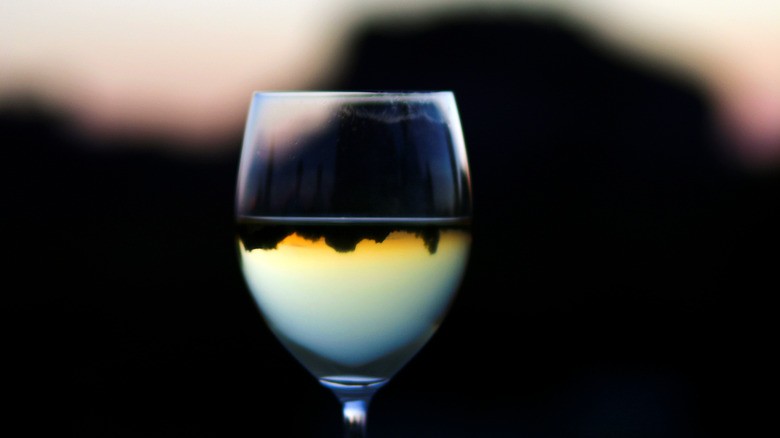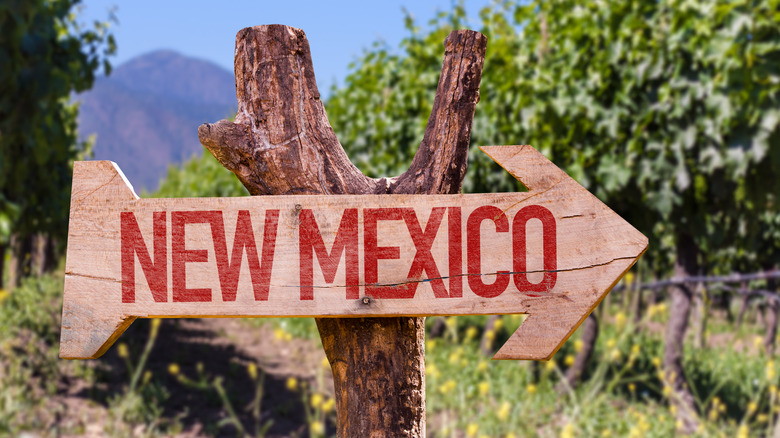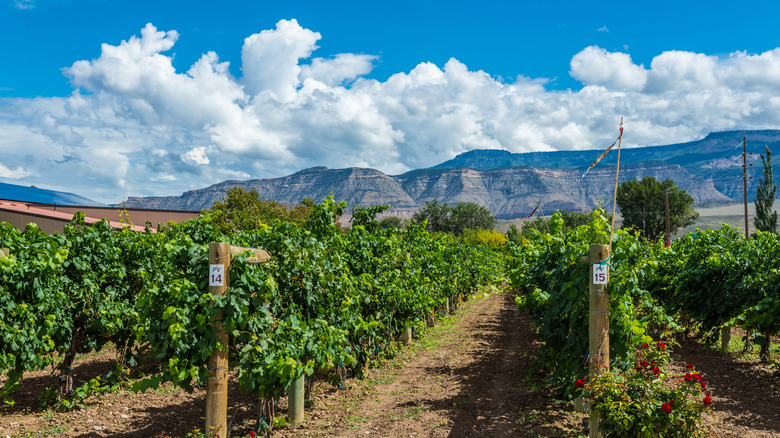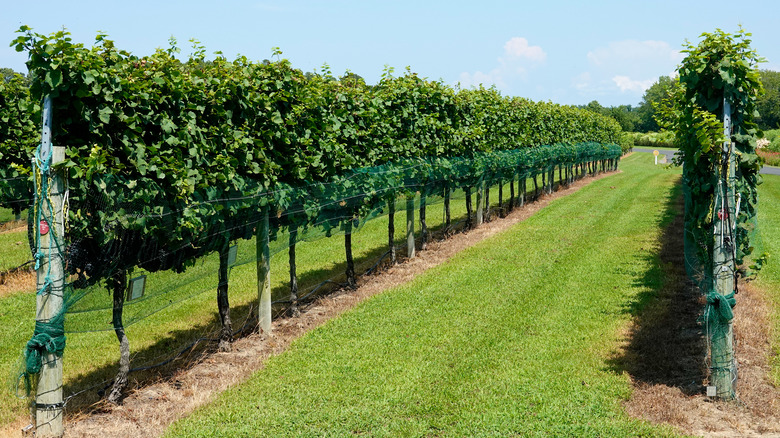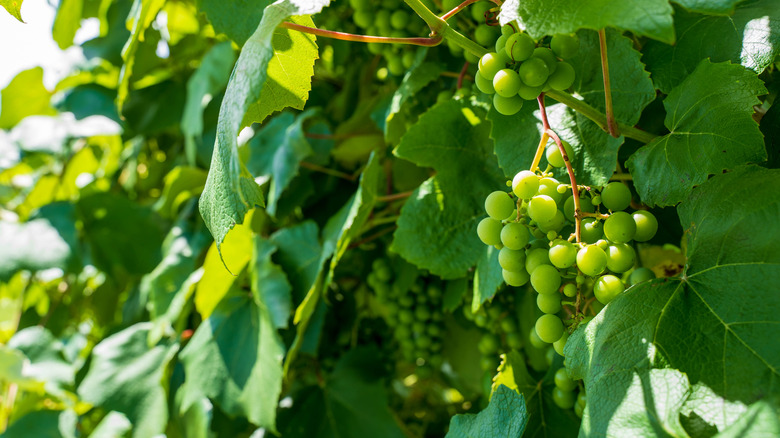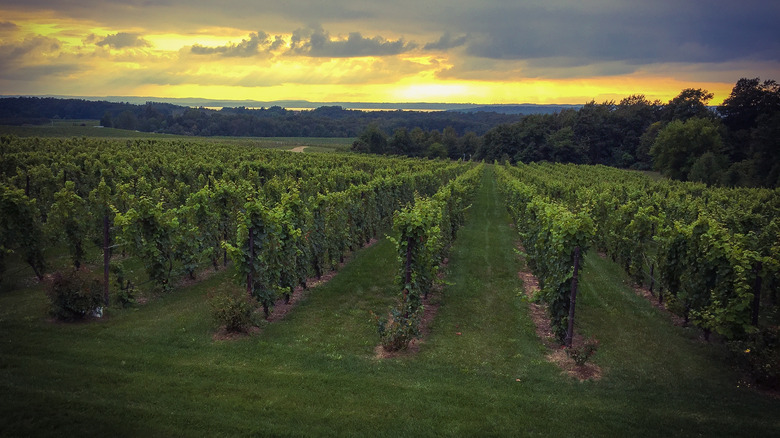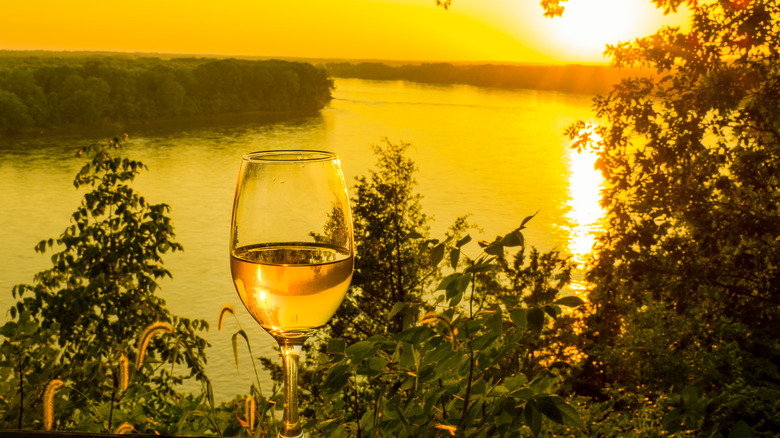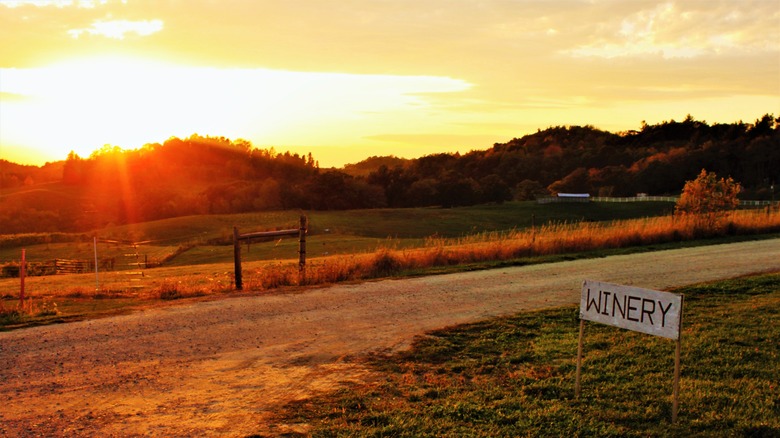14 World-Class Wine Regions That Might Be In Your Own Backyard
There is so much focus on farm-to-table cuisine and locavore practices, but why doesn't that extend to wine? Did you know that every state in the United States makes wine? Sure, there are some clunkers, but there are also world-class wineries that might be in your own backyard. California, Washington, and Oregon are already on wine lovers' radar, but there is much to discover from the other 47 states.
Most states have several AVAs (American Viticultural Areas) that showcase the geographic and climactic differences throughout the state. These differences are directly correlated to the types of grapes that will thrive there, and the best planting and farming methods. Some believe that these same reasons are why wine production could be lost over the next 50 years, but for now, it has allowed winemakers to perfect their craft. Not convinced? Check out some of these wine regions and wineries, and it might change your mind.
Virginia
Virginia is for wine lovers – even Thomas Jefferson was a Virginia wine lover. Virginia boasts over 4,000 acres under the vine, with eight distinct AVAs. From the Blue Ridge Mountains, Shenandoah Valley, and the Chesapeake Bay, to the Eastern Shores, the growing regions vary heavily across the state, allowing them to successfully work with a variety of grapes.
In Central Virginia, you can find the biggest chunk of wineries. Barboursville Vineyards makes gorgeous, age-worthy Italian varietals, Blenheim Vineyards (owned by Dave Matthews) focuses on sustainable winemaking, Early Mountain Vineyards makes clean and vibrant low-intervention wines, go watch some polo while enjoying premium wines from King Family Vineyards, for French garagiste-style wines, Stinson Vineyards is the spot, Veritas delivers stunning sparklers, and Lightwell Survey Winery is where to go for the funk and weirdness.
On the Eastern Shores, you can find The Williamsburg Winery, which boasts big, hearty wines. Northern Virginia is home to Boxwood Winery, where you can find Bordeaux-style wines, or for a bon temp, head to Breaux Vineyards. And Stone Tower Winery offers fine wines in an elegant setting. These are just a handful of what Virginia has to offer — there are about 300 wineries across the state! There is so much more to this fantastic region, where the backdrop of each tasting room is always stunning, and the wine is equally enchanting.
New York
Similar to Virginia, each corner of New York State is vastly different. You have the coastal regions in Long Island, the cool-climate regions in the Finger Lakes, the even-cooler climate of Niagara Escarpment, and the mountainous regions of the Hudson River Valley. Each of these spots boasts numerous AVAs. While they all grow Vitis vinifera suited to their climate, many also take advantage of hybrid grapes produced at Cornell, specifically for certain growing conditions.
In the Finger Lakes, because of the cool climate, you can find racy expressions of riesling, sparkling wine, pinot noir, and chardonnay. The pioneer of growing these grapes on the east coast is Dr. Konstantin Frank. Today, many wineries have followed suit, and some went their own path. Some standouts are Heart & Hands Wine Company, Lamoreaux Landing, Hosmer Estate Winery, Ravines Wine Cellars, Herman J. Wiemer Vineyard, Shaw Vineyards, Osmote, and Nathan K.
On Long Island, Bordeaux blends are the big thing, but many styles also thrive. A few to check out are Lieb Cellars, Bedell Cellars, Channing Daughters, Bridge Lane Wine, Macari Vineyards, and Sparkling Pointe.
The Hudson River Valley Region is home to terrific cabernet franc and numerous other styles. The oldest winery in the United States, Brotherhood Winery, calls the Hudson Valley home, but more contemporary wineries, such as Wild Arc Farm, are also celebrated here. Some others to put on your list are Benmarl Winery, Hudson-Chatham Winery, Fjord Vineyards, Millbrook Vineyards & Winery, and Whitecliff Vineyard & Winery.
Texas
With more than 4,000 acres of vineyards and over 500 wineries, why is Texas wine still a hidden gem? Texas has eight AVAs and produces a wide variety of styles. The biggest cluster of wineries is in the High Plains and Panhandle region, where the hot, dry summers with cool evenings have the desired diurnal effect that grapes prosper from. Other regions are in the hill area, some in the mountains, and some are on the coast, spread throughout the nine million acres of land in Texas, so you can imagine how different each AVA is.
Don't mess with Texas — check out these stunners. Becker Vineyards drives home the "bigger in Texas" saying by offering hearty reds like cabernet sauvignon, petit sirah, and sangiovese. Bending Branch does as well, also producing cabernet sauvignon but also offering tannat and tempranillo. Pedernales Cellars excels with its Texas-grown Spanish and Rhône varietals with a lighter touch. Llano Estacado is the largest premium winery in Texas, making a range of wine styles. Southold Farm + Cellar are the cool kids making terroir-specific, low-intervention wines — grab the skin contact trebbiano.
North Carolina
You've got to have faith in a wine region that boasts of being home to the "Mothervine." The Mothervine is America's oldest cultivated grapevine and has been producing muscadine grapes on Roanoke Island in the Outer Banks since 1584. Across the mountains, coast, and Piedmont regions, North Carolina has around 200 wineries.
A literal sanctuary for coastal wildlife, Sanctuary Vineyards grows syrah, tempranillo, viognier, norton, and muscadine nestled among the preserves. Located on George Vanderbilt's magnificent 8,000-acre Biltmore Estate in Asheville, Biltmore Estate Winery is a fantastic place to visit, but it's also simple to bring home a tasty souvenir online. Vidl Cellars is dedicated to natural winemaking and native fermentation. Head to Adagio Vineyards for fine wine, music, and to learn how to hand-make violins! Jones von Drehle Vineyards & Winery is a concert space with European-style wines to enjoy, and, finally, Raffaldini Vineyards & Winery is where to go for Tuscan-style wines, including appassimento wines. There are lots more to see, though!
Pennsylvania
With its sprawling farmland and focus on agriculture, it's no wonder Pennsylvania is encouraging new wineries to open and fostering the ones that are already there. It might surprise you to know that there are nearly 300 wineries and over 14,000 acres of vineyards in Pennsylvania, and it is the fifth largest wine producer in the country.
For a mix of Italian-style wines and American grapes-based wines, Penns Woods Winery pays homage to both the country owner Gino Razzi is from, as well as the state the wines are produced. Va La Vineyards is a tiny but mighty winery that offers northern Italian and French varieties made in small batches by Anthony Vietri. Meaning "voice of the vineyard," Vox Vineti focuses on vineyard health so that the wine can be produced with little interference. Finally, Galen Glen is the spot where you can experience a little Austria and Germany in Pennsylvania. It has received numerous accolades for its grüner veltliner and its riesling.
Idaho
Positioned below the fantastic Okanagan Valley wine region in British Columbia and sidled up next to Oregon and Washington, it makes sense that Idaho would be a prime grape-growing region. Idaho is known for growing and producing classic varieties, including syrah, merlot, riesling, and chardonnay, as well as Spanish and South American grapes like tempranillo and malbec. The wine region is broken up into four regions, the Northern, Southwestern, Southwestern Urban, and the South Central, with numerous AVAs within.
The most familiar winery might be Ste. Chapelle, as it has been in business since the '70s and is the only Idaho winery that is currently nationally distributed. It is known for its floral riesling but has much more to offer. Since 2009, Fujishin Family Cellars has been playing around with different varietals and perfecting the outputs of the grapes it sticks with. Bitner Vineyards prides itself on its 15 acres of vinifera wine grapes grown sustainably along the Snake River Valley. Check out Sawtooth Winery for excellent examples of riesling, pinot gris, syrah, merlot, and tempranillo grown on its impressive 400 acres of vineyards. If you are looking for funk, carbonic, and skin contact, Split Rail Winery is the spot.
Arizona
When many think of Arizona, they think of oppressive heat, miles of sandy desert, and coyotes chasing road runners, so it might come as a surprise to know that Arizona has an ideal climate for growing grapes. It's actually not all desert — there is a great variety of climates and a vast difference in elevations. Arizona also sits at 40 degrees latitude — the ideal growing conditions range from the 30 to 50-degree mark. Even the hot and flat parts see a great diurnal shift in day-to-nighttime temperatures. There are three main growing regions: hip Verde Valley which is just north of Phoenix, and the Sonoita/Elgin and Willcox regions are outside Tucson. The styles and grapes run the gamut, but the main grapes grown are chenin blanc, malvasia bianca, viognier, grenache, cabernet sauvignon, and mourvedre.
Due to his fame as a lead musician in Tool, Puscifer, and A Perfect Circle, Maynard James Keenan's winery, Caduceus Cellars & Merkin Vineyards, is one of the more well-known. It's not only known for its famous owner but also for its fantastic wines — classic iterations of sangiovese are made alongside orange wines, whole-cluster wines, and pét-nats. Some other wineries to know are Vino Stache Winery, Alcantara Vineyards, Arizona Hops and Vines, and Page Spring Cellars.
New Mexico
Nearly 400 years ago, Spanish missionaries planted grapes along the banks of the Rio Grande, New Mexico. Today, New Mexico has three AVAs within its borders, all found at higher altitudes: Middle Rio Grande Valley, Mimbres Valley, and Mesilla Valley. More than 40 wineries operate in the state today, making wines from both vinifera varieties and hybrids. It might surprise some to know that sparkling wine is the style New Mexico is known for.
Coming from Champagne, Laurent Gruet spearheaded the sparkling wine movement in New Mexico in the late 1980s with the winery he owned at the time, Gruet. People thought he was crazy at first, but as he told Bloomberg, "The hot days, cool nights, high altitude, and dry climate add up to a long growing season and weather that preserves the acidity in the grapes that sparkling wines need." Other wineries making bubbly in the state are Vara, St Clair Winery, Jacqueline Leonne, and Lescombes Family Winery. Meanwhile, Vivác Winery, Luna Rossa Winery, and others focus on still Italian varietals.
Colorado
With the viticultural world looking towards cooler climates because of climate change, we can expect to see more focus on regions like Colorado. Warm days, cool nights, ranges of elevation, and low humidity make it the perfect spot for grapes like riesling and cabernet franc.
Carlson Vineyards is known for its rieslings and gewürztraminers and prides itself on making wine fun and approachable. Another winery with gorgeous expressions of riesling is The Storm Cellar. At 5,880 feet, this is one of the highest-elevation vineyards in the Northern hemisphere, giving it the natural ability to produce dry wines bursting with acidity and concentrated floral and fruit notes. Carboy Winery is the largest winery in Colorado, making it able to produce a wide variety of styles, from a range of rosés and numerous reds and whites that span the globe via varietal. If you are looking for bright and fresh pét nats or innovative bottlings such as sparkling pear cider fermented on red grape skins with wildflower honey, Sauvage Spectrum is the spot. Maison La Belle Vie is run by John Barbier, whose family has been making wines for over 150 years in the Loire Valley. Try his Vin de Peche — a traditional wine in the Loire Valley made with muscat grapes aged in peach leaves and peach wood. The urban winery, The Infinite Monkey Theorem, is one of the pioneers of canned wines and urban wineries in general. Don't sleep on atōst's wine-based aperitifs.
New Jersey
Boasting over 2,000 acres of vineyards, New Jersey's wine industry continues to grow and improve. GSWGA said it best when describing the melange of styles and varieties in the state, saying, "Due to the different growing conditions in the state, New Jersey will never be known for one varietal but instead, like its population, offers a unique and diverse group of wines for every palate in its different wine regions." Plantings of Vitis vinifera, Vitis labrusca, and French hybrids are planted throughout the state's four AVAs.
These are some great examples of New Jersey wine: The climate and soil in the part of Hunterdon County where Mount Salem sits bears great similarities to Carnuntum and Burgenland, Austria. Leaning into that, it has been producing Austrian varieties like zweigelt and blaufränkisch. Amalthea Cellars has been growing grapes since the '70s and produces a wide variety of dry reds and whites and a number of off-dry styles. In the Outer Coastal Plain AVA, William Heritage has been making wine since 1999 and has raked in awards and accolades along the way for its vinifera offerings, as well as its Chambourcin — a French-American hybrid grape that the winery refers to as the "East Coast Red Zinfandel." Lastly, Unionville Vineyards has been making celebrated old-world style wines, using varieties from the Rhone Valley and Burgundy in France, since 1993. Recently, it began producing a pét-nat as well.
Vermont
Vermont is the home base for a number of hip, natural wineries that have been getting a lot of buzz over the past few years. Cool climate grapes like chardonnay, riesling, and zweigelt and grown among hearty hybrids like frontenac, marquette, and la crescent. Here are some wineries that are of note.
La Garagista Farm + Winery and Shelburne Vineyard walked so that others could run. La Garagista is a pioneer of natural wine in Vermont since its first vintage in 2010, its alpine wine and ciders have won the hearts of many a wine drinker. Shelburne first planted vines in 1998 and helped to change the perception of cold-hearty hybrid grapes. Others that followed include Ellison Estate Vineyard, which opened in 2018 on an abandoned vineyard in Grand Isle. Using lesser-known grapes like la crescent, St. Croix, prairie star, swenson, and louise, it makes pét-nats, co-ferments, and aperitifs, among its more straightforward wines. Stella14 Wines is a newer winery that opened in 2020. Growing frontenac noir, marquette, and frontenac blanc organically, the folks there produce the wines naturally.
Michigan
Michigan wine country is a hidden treasure spread out over the stunning Great Lakes. Growing a vast array of Vitis vinifera and French-American hybrids across its five AVAs, it has started to make a name for itself. Michigan ranks No. 6 as a United States wine region, just behind Texas.
St. Julian, on the Lake Michigan Shore Wine Trail, is the oldest and largest winery in Michigan. Incredibly, the winery produces over 60 different wines. On a completely different note, a small boutique winery, Native Species, produces minimal intervention wines in Grand Rapids. Using Michigan-grown hybrid and vinifera grapes, they are crushed by foot and native fermented. Another smaller, contemporary winery with a similar ethos is Neu Cellars. Get your crisp and racy Austrian-style wine fox at Left Foot Charley in Traverse City. Like most wineries in Michigan, Leelanau Cellars boasts gorgeous views. Situated on the Leelanau Peninsula Wine Trail, it overlooks the Grand Traverse Bay, which is the perfect spot to sip its array of wines.
Missouri
We might know a little more about Missouri after the popularity of Ozark, but Missouri's wine region is still a mystery to most. A large population of German immigrants influenced the wine industry in Missouri, notes Missouri Wine, and, today, the state produces a number of German-style wines that are sure to impress. The region also excels with hybrid grapes that are winter-hearty. Believe it or not, before Napa Valley became the nexus of American wine, the Missouri River Valley was America's capital of the wine industry.
Augusta Winery is located in the Augusta AVA, which is the first AVA that was designated in the U.S. (in 1980). It is known for its collection of hybrid and vinifera wines, as well as fruit wines. A great way to spend the day is at Balducci Vineyards, which sits on 76 acres of rolling hills. For over 20 years, guests have enjoyed its variety of dry and sweet wines. Head to Montelle Winery for views of the Missouri River Valley while sipping on some vino. For natural wine fans, try Claverach Farm in the Ozark Mountains.
Wisconsin
The Wisconsin wine scene offers an interesting mix of traditional wines and wines made from its coveted tart cherries. Another cool-climate region that is sure to explode in popularity, Wisconsin grows a number of grapes from vinifera and hybrid throughout its 80-plus wineries. The majority are hybrid-based, due to harsh and frigid winters and its humid summers, the grape varieties grown there need to be hardy and robust. A match made in heaven, Wisconsin cheese just happens to pair gorgeously with traditional wine and cherry wine alike.
Nestled on a hillside near the Wisconsin River lies Wollersheim Winery, where you can try varieties like St. Pepin and prairie. Von Stiehl Winery is Wisconsin's oldest licensed winery, producing wine from Door County and Kewaunee County orchards since 1967. Lake Michigan is in full view from the tasting room. Head to Villa Bellezza Winery to enjoy some wine in its Italian-style estate. For something more contemporary, look to Nonfiction Wines, Chromatic Wine Company, and American Wine Project.
